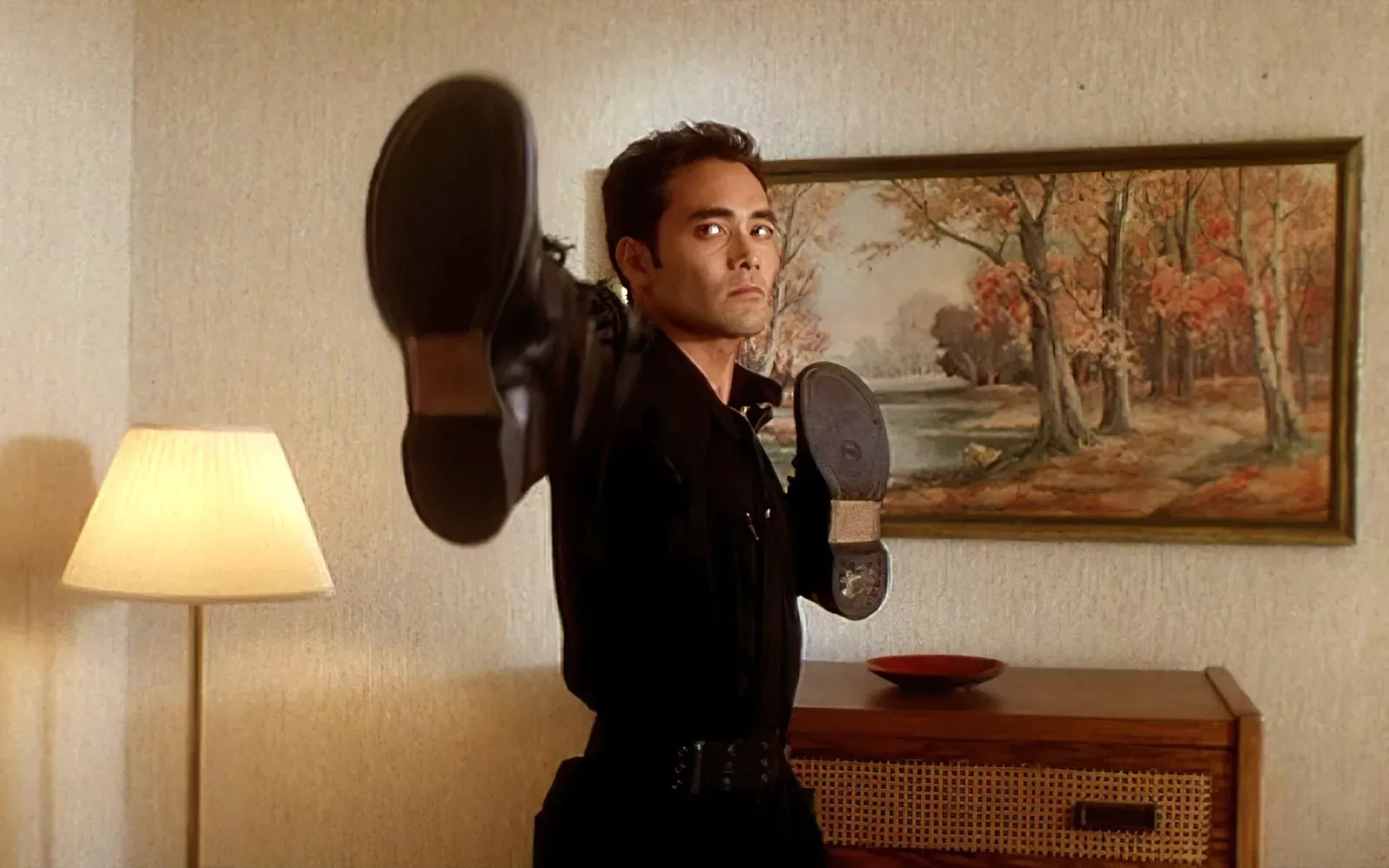Drive by Steve Wang (Review)

I can’t help feeling like Mark Dacascos has never really received the respect and appreciation that he deserves. Perhaps that’s because most people probably recognize him as the Chairman from Iron Chef America. Or because, when you look at his filmography, you see titles like The Hunt for Eagle One: Crash Point, I Am Omega, and The Lost Medallion: The Adventures of Billy Stone. (And who can forget 1994’s Double Dragon?)
Here’s the thing about Dacascos, though: he clearly has action skills and onscreen charisma, as evidenced by his scene-stealing performances in Brotherhood of the Wolf and John Wick: Chapter 3 – Parabellum. But I daresay the best display of Dacascos’ talents is 1997’s Drive, a direct-to-video title directed by Steve Wang (Guyver, Power Rangers Lost Galaxy) and co-starring Kadeem Hardison of A Different World fame.
Toby Wong (Dacascos) is a former Hong Kong agent with an advanced “bio-engine” implanted in his chest, which boosts his natural abilities and lets him perform all kinds of extremely acrobatic martial arts maneuvers. Those come in handy when Wong flees to the U.S. in order to sell the device and prevent it from falling into the hands of the sinister Leung Corporation — and is subsequently pursued by a small army of goons hired to retrieve him and the bio-engine.
While battling some of Leung’s thugs led by a cowboy assassin named Vic (John Pyper-Ferguson), Wong crosses paths with a down-on-his-luck songwriter named Malik Brody (Hardison). After making short work of Vic’s team, Wong takes Brody hostage, forcing him to drive Wong from San Francisco to Los Angeles so that he can get rid of the bio-engine.
The plot’s as threadbare as it gets, but Dacascos and Hardison do have some fun chemistry that helps sell their characters’ inevitable transition from captor and hostage to roadtrip buddies. A young Brittany Murphy, just two short years out from her breakout in Clueless, joins the pair for a short time as Deliverance, a young motel owner who takes a shine to Brody and frequently jumps back and forth between just plain quirky and mentally unbalanced.
Of course, that’s all just pretense for the action scenes, which frankly, are so much better than a direct-to-video film like this deserves. Wang, Dacascos, and action choreographer Koichi Sakamoto (who has worked on numerous Power Ranger and Kamen Rider titles) did not have to go as hard as they did for this film. I, however, am very glad they did. Put simply, Drive is a true hidden gem of an action movie. Its budget constraints might show from time to time (though Wang hides it well with his flashy camerawork), but I was never bored or not entertained.
Drive’s action choreography is clearly indebted to Jackie Chan’s films, from the frequent use of props like chairs, mattresses, and car doors to stunts clearly inspired by similar scenes in Police Story and Drunken Master 2. As for Wong’s bio-engine, that’s just a convenient excuse for Sakamoto to include some wire-enhanced action — which helps sell Wong’s superhuman abilities, particularly in his final duel with another enhanced warrior.
Dacascos’ action chops are on full display, whether he’s executing graceful flips, twirls, and pirouettes, performing intricate choreography in cramped hotel rooms, or taking out bad guys with a flourish of moves that looks like tai chi on steroids. While there’s no doubt that 90% of this is completely impractical or unnecessary — Can you really take out a machine gun-wielding dude with a graceful backflip? Do you have to use spin moves while shooting out a bad guy’s tires? — Dacascos makes it all look so effortlessly cool that realism quickly ceases being a concern or value.
I once read a review of Jackie Chan’s Police Story which theorized that it depicts a parallel universe. One where there’s always a perfectly placed prop to knock out a thug, or where it makes total sense for the bad guys to attack the heroes whilst riding dirt bikes through a shopping mall. Drive exists in a similar universe. Look no further than the film’s final battle, which takes place in a neon-covered space-themed karaoke diner replete with virtual reality simulators and an industrial design chic that does more to make it an artifact of the ’90s than the villains’ double-breasted suits. And there are even dirt bike-riding bad guys for good measure.
I first glimpsed this universe many years ago, when I caught Drive on cable TV while in college — and I thoroughly enjoyed revisiting it just now, so many years after my original exposure. If you enjoy ’90s nostalgia, classic Hong Kong-style action, scenery-chewing villains, and scenes of the heroes jumping through the air in dramatic slow motion while stuff blows up behind them, then I suspect you’ll greatly enjoy Drive’s parallel universe, too.

Note: I watched the producer’s cut of Drive, which is about 20 minutes shorter than the director’s original version. (Apparently, the production company thought Drive was too long, and that it needed a techno soundtrack — a decision that also places it squarely in the ’90s.) The original version is available on the Blu-ray edition that was released last year.